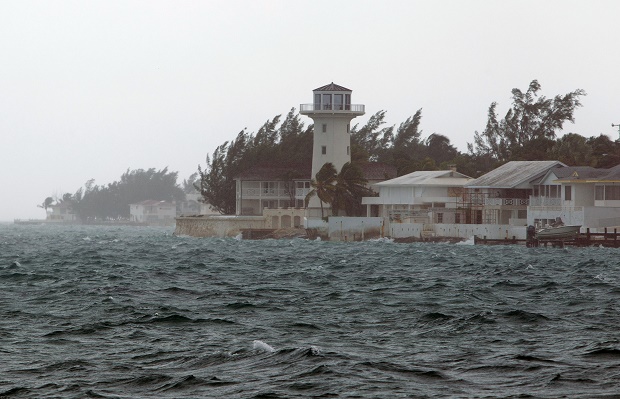
Wind and rain from Hurricane Joaquin affect Nassau, Bahamas, Friday, Oct. 2, 2015. Hurricane Joaquin dumped torrential rains across the eastern and central Bahamas on Friday as a Category 4 storm. AP Photo
ELEUTHERA, Bahamas—Hurricane Joaquin destroyed houses, uprooted trees and unleashed heavy flooding as it hurled torrents of rain across the Bahamas on Friday, and the US Coast Guard said it was trying to reach a disabled cargo ship with 33 people aboard that lost contact during the storm.
The Coast Guard said the 735-foot (224-meter) ship named El Faro had taken on water and was listing at 15 degrees near Crooked Island, one of the islands most battered by the hurricane. Officials said the crew includes 28 US citizens and five from Poland.
“This vessel is disabled basically right near the eye of Hurricane Joaquin,” said Capt. Mark Fedor. “We’re going to go and try and save lives. We’re going to push it to the operational limits as far as we can.”
Officials said they hadn’t been able to re-establish communication with the vessel, which was traveling from Jacksonville, Florida, to San Juan, Puerto Rico. The Coast Guard said the crew earlier reported it had been able to contain the flooding.
Fedor said there were 20- to 30-ft (up to 9-m) waves in the area, and that heavy winds could have destroyed the ship’s communications equipment. The ship went missing when Joaquin was a Category 4 storm. The hurricane has since lost strength and become a Category 3 storm.
On Friday evening, Coast Guard Petty Officer Jon-Paul Rios said the planes and helicopters involved in the search had returned to base because of darkness and would resume the search for the ship at first light.
Florida-based TOTE Services, the ship’s owner, said in a brief statement that it was working with the US Coast Guard and trying to establish communication with the ship.
The US National Hurricane Center said Joaquin’s threat to the US East Coast was fading as new forecasts showed it likely to curve out into the Atlantic while moving north and weakening in coming days.
But the slow-moving storm continued to batter parts of the Bahamas, cutting communication to several islands, most of them lightly populated. There had been no reports of fatalities or injuries, said Capt. Stephen Russell, the director of the Bahamas National Emergency Management Agency.
Officials were investigating reports of shelters being damaged and flooded, as well as two boats with a total of five people that remained missing.
About 85 percent of homes in one settlement of a couple dozen houses on Crooked Island were destroyed, said Marvin Hanna, an Acklins representative. He said he has had no communication with Acklins since late Thursday morning.
“At that time, vehicles were floating around and the water level was up to the windows of some homes,” he said.
Residents reached by relatives said they were “trapped in their homes, and reported feeling as if their structures were caving in,” Russell said. “It’s too dangerous to go outside because the flood waters are so high, so we ask that persons stay inside and try to go into the most secure place of their home.”
Power also was knocked out to several islands, and Leslie Miller, executive chairman of the Bahamas Electricity Corporation, said the company “is in no position to do much” to restore electricity. “All the airports are flooded,” he said.
Schools, businesses and government offices were closed as the slow-moving storm roared through the island chain.
Streets were largely deserted as people remained hunkered down on the island of Eleuthera, which was bracing for heavy winds later Friday. Some people were still making last-minute preparations, including Alexander Johnson, 61, who was moving his fishing boat with his brother, Solomon.
“It looks like it’s going to make a turn to the north, so we won’t get it in full,” Johnson said. “That’s good for us, because we’ve seen some rough ones come through here.”
Security guard Patrick Bethel said he was thankful there had been no reported casualties and wasn’t too worried about what the day would bring: “We just have to see what God will do. God controls the storm.”
Joaquin had maximum sustained winds of 125 meters per hour (205 kilometers per hour), according to the Miami-based hurricane center. By late evening, the storm was centered about 25 miles (40 kilometers) north-northeast of San Salvador, Bahamas and was moving northeast near 7 mph (11 kph).
The storm was expected to continue north away from the Bahamas, with some weakening expected on Saturday as if follows a projected path farther from the US East Coast than originally predicted.
Rick Knabb, director of the hurricane center, said Joaquin is expected to pass well offshore from the eastern seaboard.
“We no longer have any models forecasting the hurricane to come into the East Coast,” he said. “But we are still going to have some bad weather.”
In addition, the entire East Coast will experience dangerous surf and rip currents through the weekend, he said.
“Joaquin is going to generate a lot of wave energy,” Knabb said, adding that Bermuda might issue a tropical storm or hurricane watch, depending on Joaquin’s path.
The hurricane center said parts of the Bahamas could see storm surge raising sea levels 6 to 12 ft (as much as 4 m) above normal, with 12 to 18 inches (31 to 46 centimeters) of rain falling in the central Bahamas.
Authorities in the nearby Turks & Caicos Islands closed all airports, schools and government offices. Bermuda, meanwhile, issued a tropical storm watch.